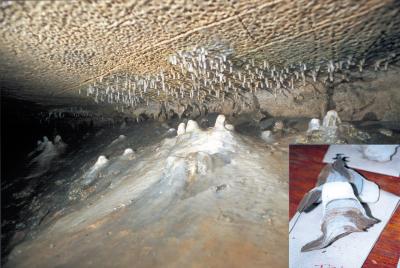
An isotope geochemist is using stalagmites to track the history of earthquakes, and potentially predict future quakes in the New Madrid Seismic Zone, reports Sarah Day.
Geoscientist Online 29 September 2008
The area where the caves are found, in South West Illinois, lies on the New Madrid Seismic Zone (NMSZ), which recorded earthquakes of magnitude 8 in 1811-12, altering the course of the Mississippi River and ringing church bells in major cities along the east coast.
Little else is known about the seismic zone’s pre-historical activity because the region was previously uninhabited, except by native Americans - who produced no written records. Scientists have relied instead on finding small mounds of liquefied sand that squirt to the surface through fractures when an earthquake occurs. Keith Hackley, an isotope geochemist with the Illinois State Geological Survey, believes the stalagmites provide a far more accurate record.
Stalagmites are formed when mineralised water trickles through crevices in cave ceilings and drips onto the floor. As the drips land on top of one another, they deposit calcium carbonate which gradually builds up to form a column. When an earthquake hits, old cracks can be sealed and new ones opened, promoting a new pattern of stalagmites on the cave floor.
Hackley and his colleagues have been using U-Th dating techniques to determine the ages of stalagmites from Illinois Caverns and Fogelpole Cave in South West Illinois. ‘We’re trying to see if the initiation of these stalagmites might be fault-induced, recording very large earthquakes that have occurred along the NMSZ,’ he said. So far, results suggest that some of the younger stalagmites began to form at around the time of the 1811-12 earthquakes.
The stalagmites are dated by using fine drills to burrow into them and collect material, which is analysed to find the ratios of the radioactive isotope thorium-230 and its parent radioactive isotope uranium-234. Whilst uranium is soluble in natural water, thorium is not, which means that when the stalagmites are first precipitated, they contain no thorium. Over time, the uranium-234 in the precipitated material decays to thorium-230. By knowing the half life of both radioactive elements, the scientists are able to estimate how long the uranium has been decaying, and thus how old the stalagmites are.
As well as finding stalagmites that formed at around the time of the 1811-12 earthquakes, they have identified seven other potential historic earthquake events, dating back as far as 18,000 years. By developing a history of seismic events along the NMSZ, possible timings of future earthquakes can be better estimated.
The preliminary results of the study will be presented in a poster at the 2008 Joint Meeting of the Geological Society of America, Soil Science Society of America, American Society of Agronomy, Crop Science Society of America, and Gulf Coast Association of Geological Societies, in Houston, Texas. Hackley and his colleagues plan to expand the study in the coming months, and will collect stalagmites from caves across Indiana, Missouri and Kentucky. They hope that the inclusion of new data will help to develop a more accurate history of the NMSZ.